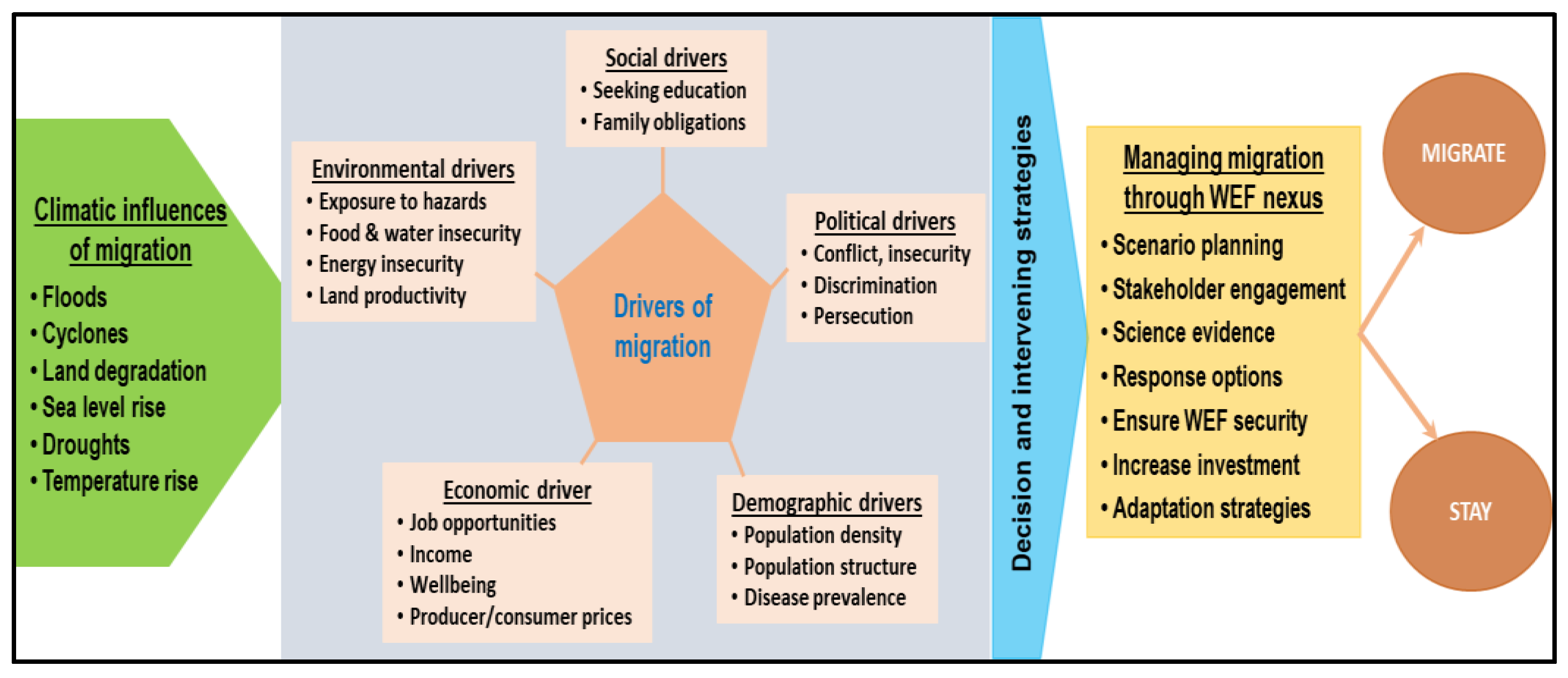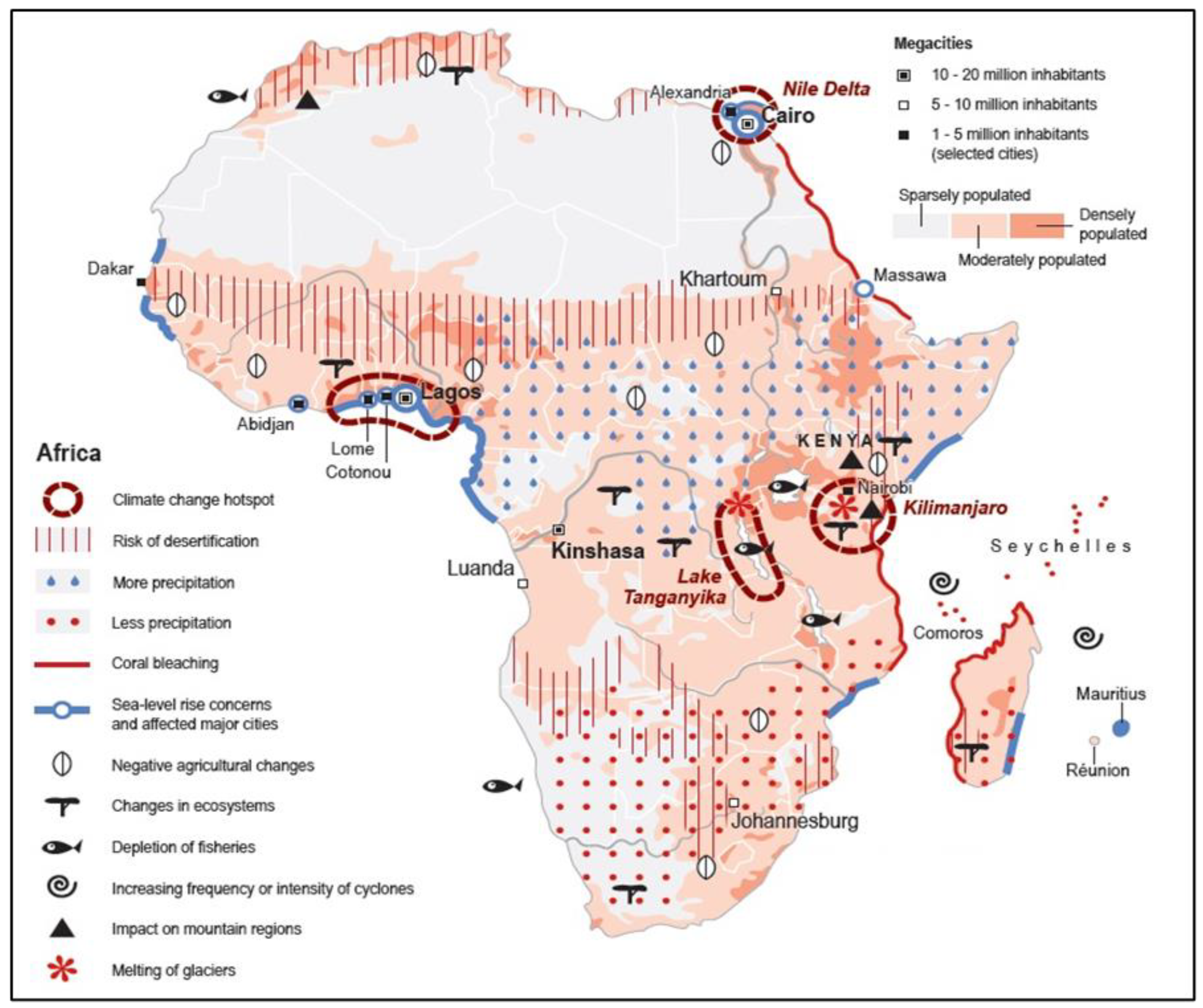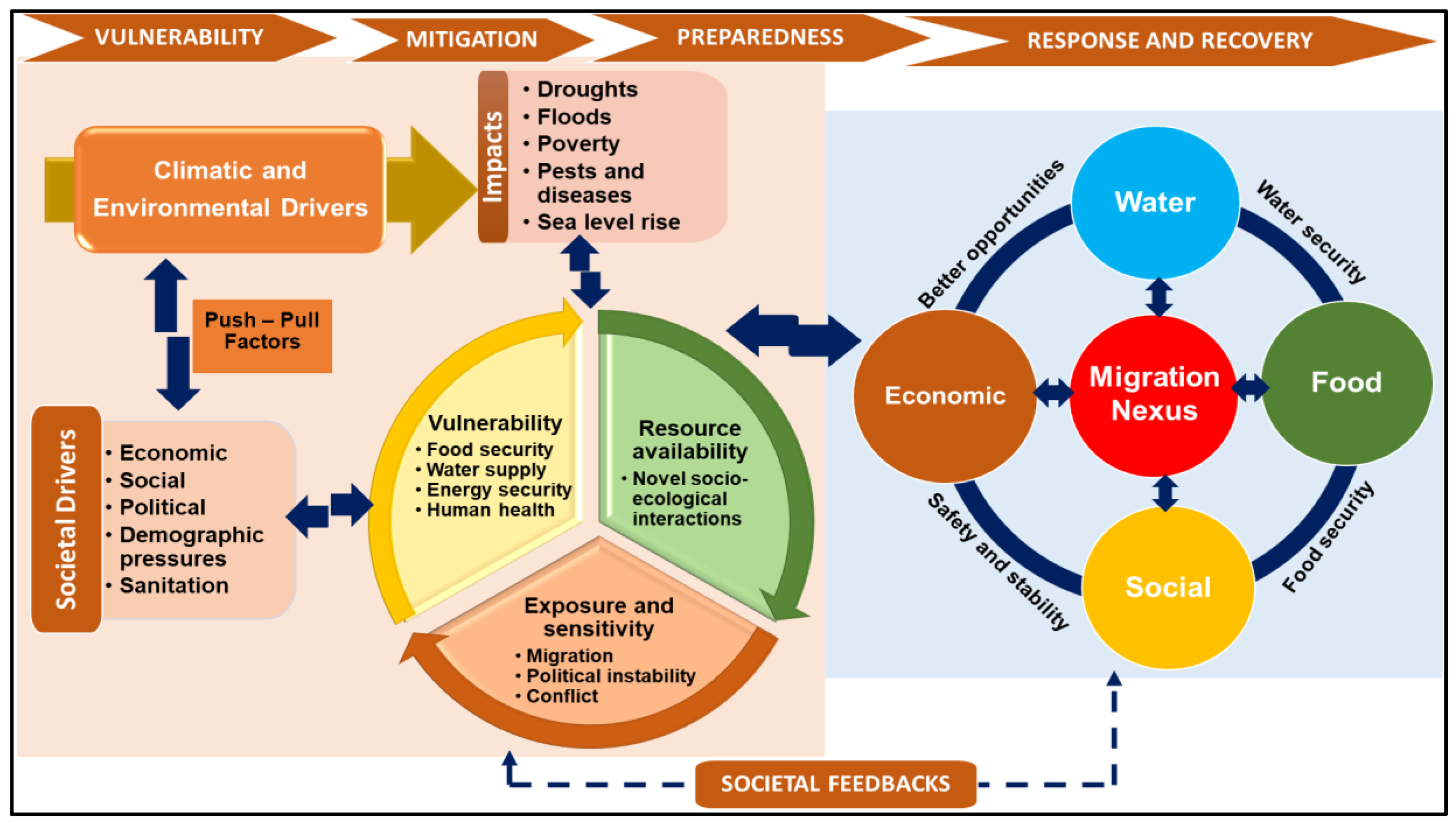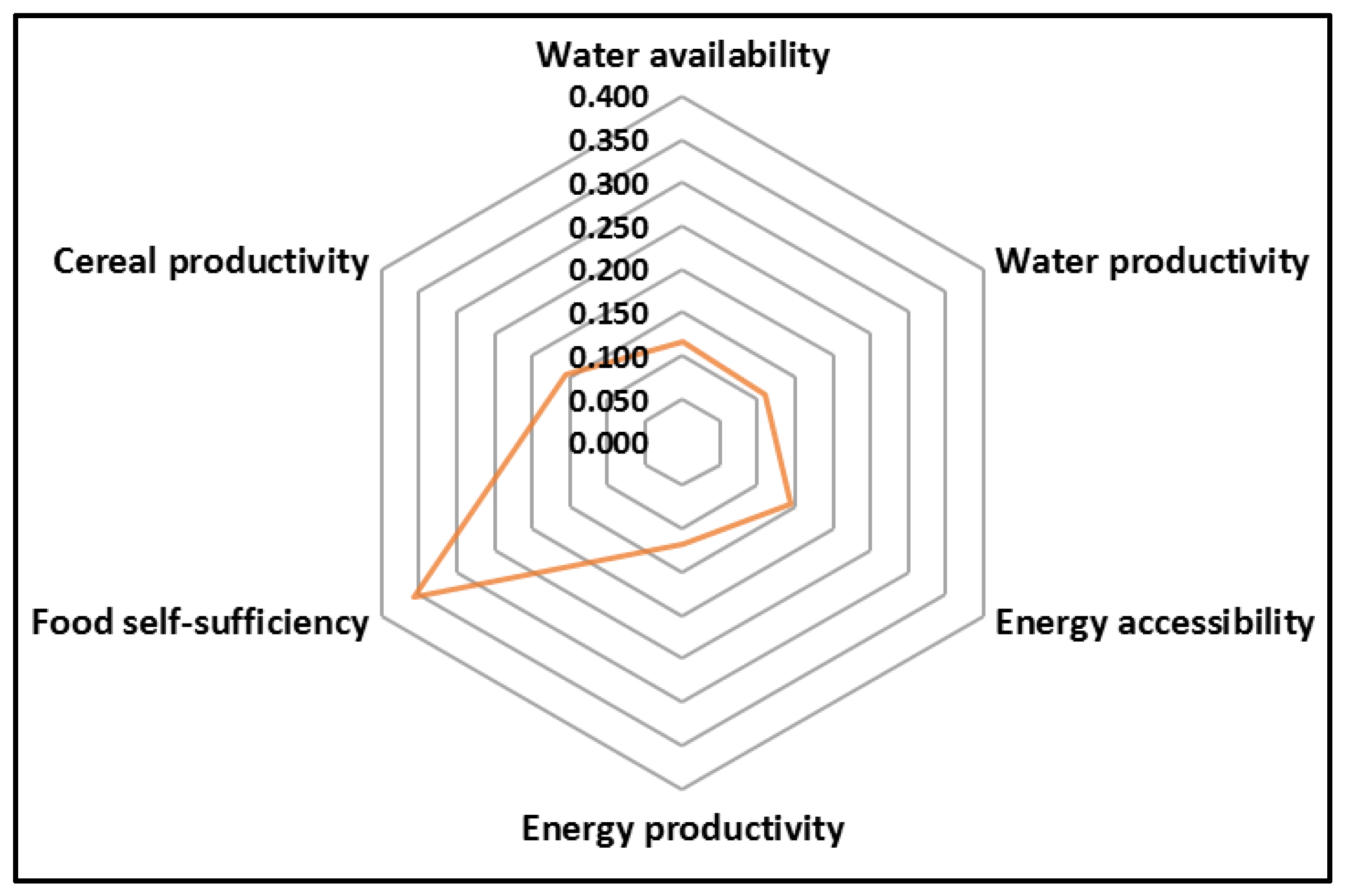Migration under Climate Change in Southern Africa: A Nexus Planning Perspective
Abstract
1. Introduction
2. Methods
2.1. Literature Review
2.2. Methodological Framework
3. Results and Discussion
3.1. Evidence from Literature: Migration Patterns, Risks and Impacts
3.2. Implications of Climate Refugees on Essential Resources
3.3. Transforming Migration into a Climate Adaptation Strategy through Nexus Planning
4. Recommendations
- a.
- There are great opportunities to benefit from leveraging and enhancing the flow of intra-regional labor migrants in southern Africa through exchange of scarce skills. Free movement of skilled labor in the region presents opportunities for inclusive economic development and regional integration, especially taking a cue from the USA and the EU;
- b.
- Planned migration presents triple benefits as the migrants themselves, the communities from where migrants come from, as well as the receiving area benefit economically [69]. This positive perspective does not consider migration as a burden on destination areas or lost brain drain on sending region;
- c.
- Coordinated regional migration has potential to enhance development strategies and could be poised to witness regional development nodes or industrial belts that could create employment opportunities through resource sharing as most of resources in the region are shared by countries [5];
- d.
- The region needs to collect disaggregated migration data in a systematic way, which may be used to inform policy decisions on addressing the drivers of migration through nexus planning. This will enable the formulation of context-based migration adaptation strategies. The analysis of such data provides long-term solutions to the challenges posed by migratory patterns such as demographic transitions and structural transformation in the society as driven by climate change.
5. Conclusions
Author Contributions
Funding
Acknowledgments
Conflicts of Interest
References
- Hugo, G. Migration, Development and Environment; International Organization for Migration (IOM): Geneva, Switzerland, 2008; p. 68. ISBN 9211036658. [Google Scholar]
- Opitz Stapleton, S.; Nadin, R.; Watson, C.; Kellett, J. Climate Change, Migration and Displacement: The Need for a Risk-Informed and Coherent Approach; Overseas Development Institute (ODI): London, UK; United Nations Development Programme (UNDP): New York, NY, USA, 2017; p. 36. [Google Scholar]
- Thomas, K.; Hardy, R.D.; Lazrus, H.; Mendez, M.; Orlove, B.; Rivera-Collazo, I.; Roberts, J.T.; Rockman, M.; Warner, B.P.; Winthrop, R. Explaining differential vulnerability to climate change: A social science review. Wiley Interdiscip. Rev. Clim. Chang. 2019, 10, e565. [Google Scholar] [CrossRef] [PubMed]
- Field, C.B.; Barros, V.R.; Mastrandrea, M.D.; Mach, K.J.; Abdrabo, M.-K.; Adger, N.; Anokhin, Y.A.; Anisimov, O.A.; Arent, D.J.; Barnett, J. Summary for policymakers. In Climate Change 2014: Impacts, Adaptation, and Vulnerability. Part A: Global and Sectoral Aspects. Contribution of Working Group II to the Fifth Assessment Report of the Intergovernmental Panel on Climate Change; Cambridge University Press: London, UK, 2014; pp. 1–32. [Google Scholar]
- Nhamo, L.; Ndlela, B.; Nhemachena, C.; Mabhaudhi, T.; Mpandeli, S.; Matchaya, G. The water-energy-food nexus: Climate risks and opportunities in southern Africa. Water 2018, 10, 567. [Google Scholar] [CrossRef]
- Alexandratos, N.; Bruinsma, J. World Agriculture towards 2030/2050: The 2012 Revision; Food and Agriculture Organisation of the United Nations (FAO): Rome, Italy, 2012; p. 154. [Google Scholar]
- Hagemann, N.; Kirschke, S. Key issues of interdisciplinary NEXUS governance analyses: Lessons learned from research on integrated water resources management. Resources 2017, 6, 9. [Google Scholar] [CrossRef]
- Lee, B.; Preston, F.; Kooroshy, J.; Bailey, R.; Lahn, G. Resources Futures; Chatham House: London, UK, 2012; p. 234. [Google Scholar]
- Tacoli, C. Urbanization, Gender and Urban Poverty: Paid Work and Unpaid Carework in the City; United Nations Population Fund (UNFPA); International Institute for Environment and Development (IIED): New York, NY, USA, 2012; p. 48. ISBN 184369848X. [Google Scholar]
- Huq, N.; Hugé, J.; Boon, E.; Gain, A. Climate change impacts in agricultural communities in rural areas of coastal Bangladesh: A tale of many stories. Sustainability 2015, 7, 8437–8460. [Google Scholar] [CrossRef]
- Ashrafuzzaman, M.; Furini, G.L. Climate change and human health linkages in the context of globalization: An overview from global to southwestern coastal region of Bangladesh. Environ. Int. 2019, 127, 402–411. [Google Scholar] [CrossRef]
- Kolmannskog, V. Climate Change, Disaster, Displacement and Migration: Initial Evidence from Africa; United Nations High Commissioner for Refugees (UNHCR): Geneva, Switzerland, 2009; p. 18. [Google Scholar]
- Anzellini, V.; Desai, B.; Fung, V.; Ginnetti, J.; Milano, L.; Montandon, R.; Ponserre, S. Global Disaster Displacemenr Risk: A Baseline for Future Work: Thematic Report; Internal Displacement Monitoring Centre (IDMC): Geneva, Switzerland, 2017; p. 40. [Google Scholar]
- Pinto-Dobernig, I. Migration and Climate Change; International Organization for Migration (IOM): Geneva, Switzerland, 2008; p. 64. [Google Scholar]
- Pillay, S.; Barolsky, V.; Naidoo, V.; Mohlakoana, N.; Hadland, A. Citizenship, Violence and Xenophobia in South. Africa: Perceptions from South. African Communities; Human Sciences Research Council (HSRC): Pretoria, South Africa, 2008; p. 59. [Google Scholar]
- Levy, B.S.; Sidel, V.W.; Patz, J.A. Climate change and collective violence. Annu. Rev. Public Health 2017, 38, 241–257. [Google Scholar] [CrossRef]
- Pasini, A.; Mastrojeni, G.; Tubiello, F.N. Climate actions in a changing world. Anthr. Rev. 2018, 5, 237–241. [Google Scholar] [CrossRef]
- Cai, R.; Feng, S.; Oppenheimer, M.; Pytlikova, M. Climate variability and international migration: The importance of the agricultural linkage. J. Environ. Econ. Manag. 2016, 79, 135–151. [Google Scholar] [CrossRef]
- Marchiori, L.; Maystadt, J.-F.; Schumacher, I. The impact of weather anomalies on migration in sub-Saharan Africa. J. Environ. Econ. Manag. 2012, 63, 355–374. [Google Scholar] [CrossRef]
- Black, R.; Bennett, S.R.; Thomas, S.M.; Beddington, J.R. Climate change: Migration as adaptation. Nature 2011, 478, 447. [Google Scholar] [CrossRef]
- Bhugra, D.; Becker, M.A. Migration, cultural bereavement and cultural identity. World Psychiatry 2005, 4, 18. [Google Scholar] [PubMed]
- Bohra-Mishra, P.; Oppenheimer, M.; Hsiang, S.M. Nonlinear permanent migration response to climatic variations but minimal response to disasters. Proc. Natl. Acad. Sci. USA 2014, 111, 9780–9785. [Google Scholar] [CrossRef] [PubMed]
- Raleigh, C.; Jordan, L. Climate change and migration: Emerging patterns in the developing world. In The Social Dimensions of Climate Change: Equity and Vulnerability in a Warming World; Mearns, R., Norton, A., Eds.; World Bank: Washington, DC, USA, 2010; pp. 103–133. [Google Scholar]
- Renaud, F.G.; Dun, O.; Warner, K.; Bogardi, J. A decision framework for environmentally induced migration. Int. Migr. 2011, 49, e5–e29. [Google Scholar] [CrossRef]
- Nhamo, L.; Mabhaudhi, T.; Magombeyi, M. Improving water sustainability and food security through increased crop water productivity in Malawi. Water 2016, 8, 411. [Google Scholar] [CrossRef]
- Mpandeli, S.; Naidoo, D.; Mabhaudhi, T.; Nhemachena, C.; Nhamo, L.; Liphadzi, S.; Hlahla, S.; Modi, A. Climate change adaptation through the water-energy-food nexus in southern Africa. Int. J. Environ. Res. Public Health 2018, 15, 2306. [Google Scholar] [CrossRef]
- De Haas, H. The Determinants of International Migration: Conceptualising Policy, Origin and Destination Effects; International Migration Institute (IMI), Oxford University: London, UK, 2011; p. 35. [Google Scholar]
- Mabhaudhi, T.; Nhamo, L.; Mpandeli, S.; Nhemachena, C.; Senzanje, A.; Sobratee, N.; Chivenge, P.P.; Slotow, R.; Naidoo, D.; Liphadzi, S. The Water–Energy–Food Nexus as a Tool to Transform Rural Livelihoods and Well-Being in Southern Africa. Int. J. Environ. Res. Public Health 2019, 16, 2970. [Google Scholar] [CrossRef]
- Nhamo, L.; Mabhaudhi, T.; Mpandeli, S.; Dickens, C.; Nhemachena, C.; Senzanje, A.; Naidoo, D.; Liphadzi, S.; Modi, A.T. An integrative analytical model for the water-energy-food nexus: South Africa case study. Environ. Sci. Policy 2020, 109, 15–24. [Google Scholar] [CrossRef]
- Biggs, E.M.; Bruce, E.; Boruff, B.; Duncan, J.M.; Horsley, J.; Pauli, N.; McNeill, K.; Neef, A.; Van Ogtrop, F.; Curnow, J. Sustainable development and the water–energy–food nexus: A perspective on livelihoods. Environ. Sci. Policy 2015, 54, 389–397. [Google Scholar] [CrossRef]
- While, A.; Whitehead, M. Cities, urbanisation and climate change. Urban Stud. 2013, 50, 1325–1331. [Google Scholar] [CrossRef]
- Boyd, E.; Juhola, S. Adaptive climate change governance for urban resilience. Urban Stud. 2015, 52, 1234–1264. [Google Scholar] [CrossRef]
- Docquier, F.; Rapoport, H. Globalization, brain drain, and development. J. Econ. Lit. 2012, 50, 681–730. [Google Scholar] [CrossRef]
- Wei, Y.; Huang, C.; Lam, P.; Sha, Y.; Feng, Y. Using urban-carrying capacity as a benchmark for sustainable urban development: An empirical study of Beijing. Sustainability 2015, 7, 3244–3268. [Google Scholar] [CrossRef]
- Van Hear, N.; Bakewell, O.; Long, K. Drivers of Migration; University of Oxford: London, UK, 2012; p. 44. [Google Scholar]
- Castelli, F. Drivers of migration: Why do people move? J. Travel Med. 2018, 25, tay040. [Google Scholar] [CrossRef] [PubMed]
- Johnson, K.M.; Voss, P.R.; Hammer, R.B.; Fuguitt, G.V.; McNiven, S. Temporal and spatial variation in age-specific net migration in the United States. Demography 2005, 42, 791–812. [Google Scholar] [CrossRef]
- Morton, J.F. The impact of climate change on smallholder and subsistence agriculture. Proc. Natl. Acad. Sci. USA 2007, 104, 19680–19685. [Google Scholar] [CrossRef]
- Heslin, A.; Deckard, N.D.; Oakes, R.; Montero-Colbert, A. Displacement and resettlement: Understanding the role of climate change in contemporary migration. In Loss and Damage from Climate Change; Springer: Berlin/Heidelberg, Germany, 2019; pp. 237–258. [Google Scholar]
- Přívara, A.; Přívarová, M. Nexus between Climate Change, Displacement and Conflict: Afghanistan Case. Sustainability 2019, 11, 5586. [Google Scholar] [CrossRef]
- Purvis, B.; Mao, Y.; Robinson, D. Three pillars of sustainability: In search of conceptual origins. Sustain. Sci. 2019, 14, 681–695. [Google Scholar] [CrossRef]
- Flahaux, M.-L.; De Haas, H. African migration: Trends, patterns, drivers. Comp. Migr. Stud. 2016, 4, 1. [Google Scholar] [CrossRef]
- Abubakar, I.; Aldridge, R.W.; Devakumar, D.; Orcutt, M.; Burns, R.; Barreto, M.L.; Dhavan, P.; Fouad, F.M.; Groce, N.; Guo, Y. The UCL–Lancet Commission on Migration and Health: The health of a world on the move. Lancet 2018, 392, 2606–2654. [Google Scholar] [CrossRef]
- Matlin, S.A.; Depoux, A.; Schütte, S.; Flahault, A.; Saso, L. Migrants’ and refugees’ health: Towards an agenda of solutions. Public Health Rev. 2018, 39, 1–55. [Google Scholar] [CrossRef]
- Davis, C.L.; Vincent, K. Climate Risk and Vulnerability: A Handbook for Southern Africa, 2nd ed.; CSIR: Pretoria, South Africa, 2017; p. 18. [Google Scholar]
- Nhamo, L.; Mabhaudhi, T.; Modi, A. Preparedness or repeated short-term relief aid? Building drought resilience through early warning in southern Africa. Water SA 2019, 45, 75–85. [Google Scholar] [CrossRef]
- Guha-Sapir, D.; Below, R.; Hoyois, P. The International Disaster Database. Centre for Research on the Epidemiology of Disasters (CRED): The CRED/OFDA International Disaster Database; Université Catholique de Louvain: Brussels, Belgium, 2019. [Google Scholar]
- CARE. Fleeing Climate Change: Impacts on Migration and Displacement; CARE International: Copenhagen, Denmark, 2016; p. 50. [Google Scholar]
- Besada, H.; Werner, K. An assessment of the effects of Africa’s water crisis on food security and management. Int. J. Water Resour. Dev. 2015, 31, 120–133. [Google Scholar] [CrossRef]
- Atapattu, S.A.Y. A New Category of Refugees? In Climate Refugees; ROUTLEDGE in association with GSE Research: Abingdon, UK, 2018; Volume 34, pp. 34–51. [Google Scholar]
- Ionesco, D.; Mokhnacheva, D.; Gemenne, F. The Atlas of Environmental Migration; Routledge: London, UK; New York, NY, USA, 2017; p. 71. [Google Scholar]
- Mabhaudhi, T.; Mpandeli, S.; Madhlopa, A.; Modi, A.T.; Backeberg, G.; Nhamo, L. Southern Africa’s water–energy nexus: Towards regional integration and development. Water 2016, 8, 235. [Google Scholar] [CrossRef]
- Bank, W. The Zambezi River basin a multi-sector investment opportunities analysis. In Modeling, Analysis and Input Data; The World Bank Washington, DC: Washington, DC, USA, 2010; Volume 4, p. 158. [Google Scholar]
- Mabhaudhi, T.; Mpandeli, S.; Nhamo, L.; Chimonyo, V.G.; Nhemachena, C.; Senzanje, A.; Naidoo, D.; Modi, A.T. Prospects for improving irrigated agriculture in southern Africa: Linking water, energy and food. Water 2018, 10, 1881. [Google Scholar] [CrossRef]
- Chilonda, P.; Minde, I. Agricultural growth trends in Southern Africa. In Policy Brief: Regional Strategic Analysis and Knowledge Support System for Southern Africa (ReSAKSS-SA); International Water Management Institute (IWMI): Pretoria, South Africa, 2007; p. 4. [Google Scholar]
- Grillitsch, M.; Hansen, T. Green industry development in different types of regions. Eur. Plan. Stud. 2019, 27, 2163–2183. [Google Scholar] [CrossRef]
- De Haas, H.; Czaika, M.; Flahaux, M.L.; Mahendra, E.; Natter, K.; Vezzoli, S.; Villares-Varela, M. International Migration: Trends, Determinants, and Policy Effects. Popul. Dev. Rev. 2019, 45, 885–922. [Google Scholar] [CrossRef]
- Barnett, J.; Webber, M. Accommodating Migration to Promote Adaptation to Climate Change; Commission on Climate Change and Development (CCDC): Stockholm, Sweden, 2009. [Google Scholar]
- Schwan, S.; Yu, X. Social protection as a strategy to address climate-induced migration. Int. J. Clim. Chang. Strateg. Manag. 2018, 10, 43–64. [Google Scholar] [CrossRef]
- Albrecht, T.R.; Crootof, A.; Scott, C.A. The Water-Energy-Food Nexus: A systematic review of methods for nexus assessment. Environ. Res. Lett. 2018, 13, 043002. [Google Scholar] [CrossRef]
- Hoff, H. Understanding the Nexus: Background Paper for the Bonn2011 Conference: The Water, Energy and Food Security Nexu; Stockholm Environment Institute (SEI): Stockholm, Sweden, 2011; p. 52. [Google Scholar]
- Meadows, D.H.; Meadows, D.H.; Randers, J.; Behrens, W.W., III. The Limits to Growth: A Report to the Club of Rome. A Report for the Club of Rome on the Predicament of Mankind; Universe Books: Washington, DC, USA, 1972; p. 211. [Google Scholar]
- Breslow, S.J.; Allen, M.; Holstein, D.; Sojka, B.; Barnea, R.; Basurto, X.; Carothers, C.; Charnley, S.; Coulthard, S.; Dolšak, N. Evaluating indicators of human well-being for ecosystem-based management. Ecosyst. Health Sustain. 2017, 3, 1–18. [Google Scholar] [CrossRef]
- Shilling, F.; Khan, A.; Juricich, R.; Fong, V. Using indicators to measure water resources sustainability in California. In Proceedings of the World Environmental and Water Resources Congress 2013: Showcasing the Future, Cincinnati, OH, USA, 19–23 May 2013; pp. 2708–2715. [Google Scholar]
- Ciegis, R.; Ramanauskiene, J.; Startiene, G. Theoretical reasoning of the use of indicators and indices for sustainable development assessment. Eng. Econ. 2009, 63, 33–40. [Google Scholar]
- Maunganidze, O.A.; Formica, J. Freedom of Movement in Southern Africa: A SADC (Pipe) Dream? Institute for Security Studies (ISS): Pretoria, South Africa, 2018; p. 24. [Google Scholar]
- Nshimbi, C.C.; Fioramonti, L. The will to integrate: South Africa’s responses to regional migration from the SADC region. Afr. Dev. Rev. 2014, 26, 52–63. [Google Scholar] [CrossRef]
- Zimmermann, K.F. European labour mobility: Challenges and potentials. De Econ. 2005, 153, 425–450. [Google Scholar] [CrossRef]
- Satterthwaite, D. The impact of urban development on risk in sub-Saharan Africa’s cities with a focus on small and intermediate urban centres. Int. J. Disaster Risk Reduct. 2017, 26, 16–23. [Google Scholar] [CrossRef]




| Continent | Drought Events | People Killed | Affected People | Total Damage (‘000 US$) |
|---|---|---|---|---|
| Africa | 312 | 867,131 | 414,235,329 | 6428,593 |
| Americas | 152 | 77 | 109,375,181 | 59,671,139 |
| Asia | 167 | 9663,400 | 2107,113,716 | 42,718,264 |
| Europe | 42 | 1200,002 | 15,488,769 | 25,481,309 |
| Oceania | 29 | 684 | 1074,2019 | 11,586,000 |
| Total | 702 | 11,731,294 | 2656,955,014 | 145,885,305 |
| Component | Sub-Component | Indicator | SDG Indicator |
|---|---|---|---|
| Water | Water security | Proportion of available freshwater resources per capita | 6.4.2 |
| Proportion of crops produced per unit of water used | 6.4.1 | ||
| Food | Food security | Prevalence of moderate/severe food insecurity in the population | 2.1.2 |
| Proportion of sustainable agricultural production per unit area | 2.4.1 | ||
| Societal factors | Safety and stability | Conflict-related deaths per 100,000 population | 16.1.2 |
| Proportion of population satisfied with public service experience | 16.6.2 | ||
| Economic factors | Better opportunities | Proportion of population living below the poverty line | 1.2.1 |
| Proportion of population living in households with access to basic services | 1.4.1 |
© 2020 by the authors. Licensee MDPI, Basel, Switzerland. This article is an open access article distributed under the terms and conditions of the Creative Commons Attribution (CC BY) license (http://creativecommons.org/licenses/by/4.0/).
Share and Cite
Mpandeli, S.; Nhamo, L.; Hlahla, S.; Naidoo, D.; Liphadzi, S.; Modi, A.T.; Mabhaudhi, T. Migration under Climate Change in Southern Africa: A Nexus Planning Perspective. Sustainability 2020, 12, 4722. https://doi.org/10.3390/su12114722
Mpandeli S, Nhamo L, Hlahla S, Naidoo D, Liphadzi S, Modi AT, Mabhaudhi T. Migration under Climate Change in Southern Africa: A Nexus Planning Perspective. Sustainability. 2020; 12(11):4722. https://doi.org/10.3390/su12114722
Chicago/Turabian StyleMpandeli, Sylvester, Luxon Nhamo, Sithabile Hlahla, Dhesigen Naidoo, Stanley Liphadzi, Albert Thembinkosi Modi, and Tafadzwanashe Mabhaudhi. 2020. "Migration under Climate Change in Southern Africa: A Nexus Planning Perspective" Sustainability 12, no. 11: 4722. https://doi.org/10.3390/su12114722
APA StyleMpandeli, S., Nhamo, L., Hlahla, S., Naidoo, D., Liphadzi, S., Modi, A. T., & Mabhaudhi, T. (2020). Migration under Climate Change in Southern Africa: A Nexus Planning Perspective. Sustainability, 12(11), 4722. https://doi.org/10.3390/su12114722








